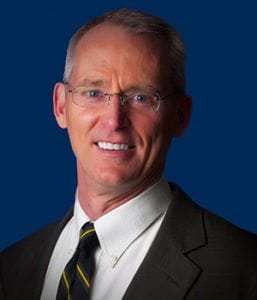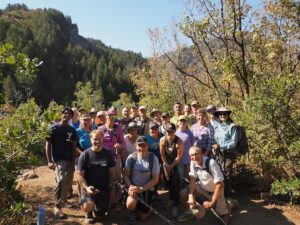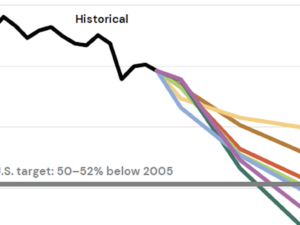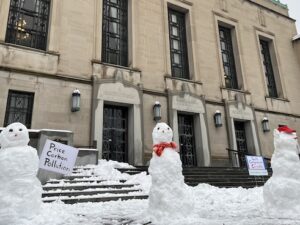
Utah state Rep. Becky Edwards (left) co-sponsored a bipartisan carbon pricing bill. Student advocacy helped set the stage for this bill and a recently passed climate resolution.
Utah’s climate resolution & bipartisan carbon pricing bill
By Bryan Debbink
Climate change: Two words that could be a poison pill for any bill in a state with an 83% Republican legislative majority. But change sometimes comes from unexpected corners. The 2018 legislative session, which ended earlier this month, was a hopeful one for climate advocates in Utah. It included the introduction of HB403, the first bipartisan carbon tax bill in the nation which has not yet passed, as well as HCR7, a resolution recognizing a warming climate and asserting Utah’s responsibility for action to address it while promoting a growing economy. This resolution did pass on the final day of the legislative session earlier this month and was signed by Gov. Herbert this week.
Utah’s bipartisan carbon pricing bill
HB403, introduced by Joel Briscoe (D-Salt Lake) and co-sponsored by Becky Edwards (R-Davis) and Dixon Pitcher (R-Weber), would assess an upstream fee of $10/ton of CO2 increasing by 3.5% plus inflation each year. Net proceeds then return to the economy via eliminating a variety of state taxes, such as sales taxes on grocery store food or income taxes on mining and manufacturing businesses. In addition to eliminating taxes, the funds would also fund an Earned Income Tax Credit (EITC) match, where families affected by intergenerational poverty would receive a Utah state tax credit equal to 75% of their federal EITC amount.

Rep. Joel Briscoe
As economist Yoram Bauman puts this “tax swap” concept, “The basic idea of HB403 is to tax ‘bads’ instead of ‘goods.’” In other words, reduce taxes on productive items (basic human needs and profit) and offset by increasing taxes on the counterproductive (pollution, CO2). “Utah currently has a sales tax on grocery store food, for example, so why not replace that with a tax on carbon emissions? Taxing pollution instead of potatoes — what a fine idea!”
A key part of the proposal are the tax reductions for impacted industries. “HB403 also reduces business taxes for mining and manufacturing companies to help them maintain competitiveness,” says Bauman. “At the federal level this could be done with a Border Tax Adjustment, but at the state level that’s impractical.” To the environmentally focused groups, this may seem like a giveaway to business that runs counter to the goal of reduced emissions. However, these concessions account for a narrow portion of Utah’s overall emissions, while ensuring major employers in Utah remain major employers in Utah, thereby avoiding devastating smaller communities with a key industrial employer.
Where is the bill now?

Rep. Becky Edwards
Due to its complexity, HB403 was finalized too late in the 45-day Utah legislative session for consideration by the House, though this type of legislation is exactly what HCR7 envisions: providing incentives for reducing emissions, while growing the economy. “For the first time, the state of Utah has recognized the existence of a changing climate, factors that contribute to these changes, and the potential negative effects on the state of Utah,” said Rep. Becky Edwards, who sponsors the resolution in addition to co-sponsoring HB403. The resolution passed with wide margins both House and Senate on March 8, the very last day of the session.
The passage of HCR7 is a far cry from what the legislature resolved in 2010 (HJR12), calling on the EPA to halt its carbon dioxide reduction programs. It went on to reference “the current downturn in global temperatures,” “climategate,” and “$7 billion annually in federal government grants may have…produced a ‘scientific consensus.’” Before and since then, Utah has seen continued cycles of pollution-laden winter inversions, temperatures rising at twice the global average, and significantly reduced snowpack, which is the lifeblood of Utah in an otherwise arid region. Now, it seems, legislators may be ready to address these issues.
Utah students set the stage
In 2016, a group of students from Logan High School and Utah State University decided they had seen enough foot-dragging and drafted a resolution, submitted during the 2017 legislative session. After a heroic effort to simply have a hearing for it in the House Economics and Workforce committee, it failed on a 5-5 vote in the largely Republican committee. “The students were devastated,” recalled Jack Greene, CCL Cache Valley co-leader, who worked extensively with the group. “Only one vote shy of going to the House floor.”
Following that narrow defeat, the student group showed their moxie by working with local representatives and CCL members to revise the language without sacrificing the overall message. “Unbeknown to the students, this failure was to their advantage,” Jack said. “It would allow a full year to build support for their resolution.” In conjunction with Rep. Edwards, and a plethora of other environmental organizations, the group organized multiple bipartisan or nonpartisan public events with lawmakers and gathered support from a wide variety of Utah businesses, ranging from the ski industry to energy sector players Rocky Mountain Power and Rio Tinto, a multinational mining company.
And so, after two legislative sessions of hard work, HCR7 passed overwhelmingly in both legislative chambers with an anticipated signature from Gov. Herbert. Given the perspective of recent Utah politics, this stands as quite an achievement — driven largely by a dedicated group of young citizens. Below is a video playlist of several students’ testimonials in support of the resolution, with Rep. Becky Edwards in the center:
Jack said, “We, who had spent countless hours moving it through, so many hours of hope against hope, were elated.” Even I, your author who had not spent those countless hours, teared up as the final Senate votes came in. Jack closed his remarks with me saying, “If this happened in Utah, might it be possible in other deep red states? Perhaps our story will give them hope, and set things in motion, and from there, a Carbon Fee & Dividend with the U.S. Congress!”
The path forward for a carbon price in Utah
Coming back to HB403, we find HCR7 setting the stage for the future. Among several nonpartisan groups moving on this is ‘Climate Utah.’ Formed by CCL Salt Lake members in January 2018, Climate Utah seeks to drive positive consensus around pricing carbon in Utah. As in other states, carbon pricing will likely look different than the CCL-backed Fee and Dividend proposal, so it remains important to distinguish between the organizations.
The group sees HB403 as a very balanced solution to pricing carbon. “It was designed as a tax-swap instead of a dividend to better appeal to tax-cutting conservatives in Utah,” said Tom Moyer, a Climate Utah member and leader in the Salt Lake City CCL chapter. Despite Utah’s entrenched fossil fuel interests, Moyer remains characteristically bullish. “The renewable energy industry is booming. Rural districts are pushing for the next renewable energy projects to be built in their areas.”
Voices from across the spectrum agree. “Utah is breaking the seal on bipartisan efforts to put a price on carbon,” HB403 sponsor Rep. Briscoe said. “And it paves the way for Republicans across the country to be leaders on the issue of the changing climate.”

Bob Inglis
Bob Inglis, former U.S. Rep (R-SC4) and Executive Director of RepublicEn.org backs him up, saying, “Republican Rep. Becky Edwards and Democratic Rep. Joel Briscoe are modeling for the whole country the spirit and the solutions that America needs to lead the world to climate solutions.”
BYU student and organizer of The Climate Campaign Nick Huey words are perhaps most important for our shared future. “This bill is a real life example of state officials forgetting politics in favor of actual leadership. I’m excited to see climate change addressed as a people issue, not a party one.” He adds, “It would be the kind of come-from-behind upset that us millennials have been praying for.”
Utah has a very limited legislative calendar, which means that the next significant chance for HB403 or a similar bill is in January of 2019. Hopefully, like HCR7, the time provides a large window for Climate Utah to build alliances in the legislature and business groups to enact real change in 2019.
These are exciting times for climate action in Utah. HCR7 was a huge step forward in a deep-red state. HB403 is another. To get involved, contact your fellow citizens at Climate Utah through the website at climateutah.com. All hands on deck!
Bryan Debbink is a Domestic Engineer (stay at home dad), CCL Salt Lake member, and a member of Climate Utah.





